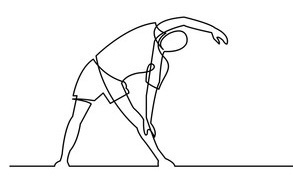The 40+ year old athlete needs all of the advantages they can squeeze out of their body, and that’s why we workout. However, this age group starts to run into a wall of fatigue and/or injury with workouts that they didn’t have a problem with just 5 years prior. While you cannot outrun time, you can slow it down with the proper exercise recovery strategies. Recovery modalities are activities or gadgets that hasten the body’s natural recovery processes. Below are 5 strategies I employ to shorten the my recovery time after a hard workout.
Sleep
Get some sleep! It is not an accident that I am mentioning sleep first in this list of recovery modalities. If you don’t dial in your sleep, no other recovery strategy is going to work. Eight hours, plus or minus 1.5 hours, seems to be the scientific consensus of the appropriate amount of sleep one requires. People who possess a single copy of the ADRB1 gene can function on less than 6.5 hours a night with no ill effects, but they are very rare. If you think you have that gene, odds are you don’t. Statistically speaking your odds of having this gene are .004%. Quality of sleep is as important as quantity. Some sleep quality strategies include refraining from alcohol at least two hours prior to going to bed. Keep your room cool and very dark. Keep a consistent routine, going to bed and waking up at the same time most days. Finally, prior to bedtime try to down-regulate your body with some of the recovery strategies below.
Compression
Muscle compression is a recovery modality that is underrated. Compression can be anything from special tight fitting clothing, foam rolling and pneumatic compression garments. As you workout, the stress you are driving through you muscles does damage at the cellular level. This damage causes a local inflammatory reaction as your immune system attempts to repair the damaged muscles. The damaged cells, inflammatory byproducts, and blood tend to pool up in your muscles faster than the body can remove it. Compression of the muscles aids the lymphatic system in removal of the cellular, “garbage,” and excess blood, returning it to your circulatory system. The easiest form of compression is foam rolling after a workout or later in the day. Another option is wearing compression garments on the lower and/or upper extremities. Lastly, some fitness nerds like myself have invested in pneumatic compression boots and sleeves. These boots and sleeves have air pumped into them to massage the lymphatic system from the most distal parts, toes and fingers up to more proximal areas on the body.
“Recovery” Workout
The day after a hard workout, I generally want to hit the couch and remain motionless as soon as the opportunity presents itself. Conversely, doing a, “recovery workout,” is a better strategy. That said, when using this strategy you have to be careful to walk the line between moving enough to compel the body to speed up your recovery versus digging yourself deeper into a fitness hole. For example, if did a hard 5 mile trail run on Monday, Tuesday will find me just walking a couple miles. If I had a hard Jiu-Jitsu class, the next day I will be on the floor for an hour stretching, foam rolling, and regaining positions like a deep squat. The point is to gently coax your body back into movements and positions that express the soreness and stiffness from the previous workout.
A daily movement practice, such as yoga or Pilates is the great recovery strategy to ensure a healthy and active lifestyle as you age. As an aging athlete, a daily and intentional movement practice is the best thing you can do for your physical and mental health, aside from sleep. If you exercise daily, a movement practice will help restore any loss of movement your joints and muscles experience as you tighten up and recover from your workout. Conversely, if you sit a lot your body needs to explore different positions and patterns that you don’t express throughout the day. Essentially, if you don’t express those unused movement patterns you will gradual lose access to them. For both camps, sedentary and active, a daily movement practice puts you back in touch with your body allowing you to observe both improvements and loss in movement range and strength.
Cold Plunge & Sauna
A cold plunge and sauna are also great recovery modalities. Both of these instruments of torture are amazing for muscular and cardiovascular recovery. The vasoconstriction (blood vessels constriction) associated with getting into a cold plunge has a similar effect to muscular compression noted above. The vasodilation (blood vessel dilation) associated with getting out of the cold plunge is great for perfusion of your sore muscles with blood. Anecdotally, the analgesic effect of the cold water and the dopamine spike get me moving the next day after a hard workout. The sauna also has a dramatic vasodilation effect on your cardiovascular system pushing blood out to your peripheral muscles. Additionally, the sauna has a cardiovascular benefit that is the equivalent of a moderately difficult run. Hitting the sauna after a workout has the benefit of extending that workout’s cardiovascular benefit, while allowing your musculoskeletal system to recover.
Much of my job as a physical therapist employs similar strategies in helping my patients recover from injury. More specifically, I try to enhance the body’s natural healing mechanisms as it responds to an injury using strategies like compression and movement. If you have a nagging injury that is holding you back or just not going away fast enough, consider employing some of the activities I mentioned above. If you still can’t shake that injury, consider contacting me at derecksteffe@returntosportphysio.com. Together we can put together a recovery strategy to get you back on the trails, slopes, court, etc.



